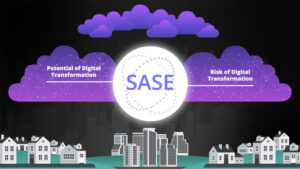
Secure Access Service Edge (SASE) is a secure way to connect users and their devices to services and resources regardless of their location.
The SASE framework is the most appropriate model to foster secure digital transformation. CIO Magazine describes digital transformation as a crucial disruption that helps to improve the method of making value available to a customer.
It is specifically perceived as the mode of deploying modern technologies and processes to boost the efficiency, delivery, and intelligence of organizational operations.
Digital transformation recreates how technology and processes are being implemented in the pursuit of revenue and new business models, driven by appropriate market research.
Building an effective and secured digital transformation requires SASE support, and organizations need to know how this works to boost the security and visibility of their business.

The Challenges of Enterprise Visibility and Security
Companies need complete access and control of corporate data from any location — device, applications, data center premise, or any type of cloud service — to leverage full digital transformation benefits.
Secure digital transformation necessitates a comprehensive and simpler contextual policy control by harnessing complete insight into the organization’s user data, shares, downloads, and uploads.
The SASE technology model helps to provide a dynamic security control point across an organization’s IT infrastructure using an integrated security setup to access control and visibility.
SASE curates all the elements of traditional network security with cloud security functionality to generate an integrated and unified security platform for providing high security for cloud data and connecting it.
It offers security services from a unified cloud-delivered architecture while employing a single dashboard and effecting the same policies to enable rapid remote access and cloud adoption. Here are examples of common elements of digital transformation initiatives
Remote Work
Organizations across the globe have seen a rise in remote work after seeing the immense benefits during the Covid-19 pandemic. Businesses were able to leverage work-from-home opportunities to continue running and have, after that, created indefinite systems to support remote work for some of their employees.
Cloud Adoption
Cloud computing has become a widely embraced system in almost every organization, executing some cloud investments. These cloud-based services and corporate IT infrastructure is distributed across diverse environments of vendors.
Bring Your Own Device (BYOD) Policies
These policies have proven to increase efficiency and accessibility since they allow employees to work from the devices they are most comfortable with. Altogether, it makes employees happier and organizations more successful.
Internet of Things (IoT) Devices
IoT devices support centralized management and monitoring of remote systems for more productivity. Tremendous growth is anticipated over corporate IT adoption, with the growth of 5G networks that have better supported a dense variety of devices and support higher data speed.
These new attributes have been of greater benefit to companies in satisfying customers’ expectations. And they also serve as a major shift in the way organizations function, considering top-level security.
SASE Security Framework Is Designed To Suit Modern Business
While corporate institutions invest in and boost their IT infrastructure, it is necessary to direct similar efforts towards securing company resources. SASE helps to solve insecurity issues and support digital transformation efforts.
SASE effects software-defined WAN (SD-WAN). SD-WAN is a network solution that optimizes traffic routing between SASE Points of Presence (PoPs).
And since being deployed as a cloud-based solution to enhance network operation for business traffic.
Unlike traditional security solutions, the enhanced operation of a network doesn’t affect the security and visibility of the network in any way. Each SASE PoP incorporates full-stack protection to support organization security, monitor activities around its resources, and implement policies on traffic linked to the SASE network.
An impressive SASE network performance will help route an organization’s business traffic over the corporate WAN without affecting network performance or latency.
An approach that can even foster increased SASE network speed is if it is built on dedicated links. The speed may be much more than routing traffic directed over broadband, straight to its destination.
Getting Started With SASE
When some people discover the security capability of the SASE framework, they get bothered about the funds and time needed to effect the transition from a traditional security network for their organization. But the best approach is to modernize your own network security, moving at your own speed.
Transitioning can be effected in a phased strategy without interrupting the operations.
A SASE security model will fit into your existing system and allow new services to be incorporated as required. The deployment process entails digital transformation to move to SD-WAN and enhance the security elements.
Conclusion
Businesses that embrace a SASE security framework will be able to speed up the adoption of cloud tools and applications. And the framework will facilitate a successful digital transformation exploration, linking security capabilities, cloud applications, and improved customer experience.
When a sound digital transformation process is implemented, it will help achieve the full SASE architecture’s potential.





Comments (1)